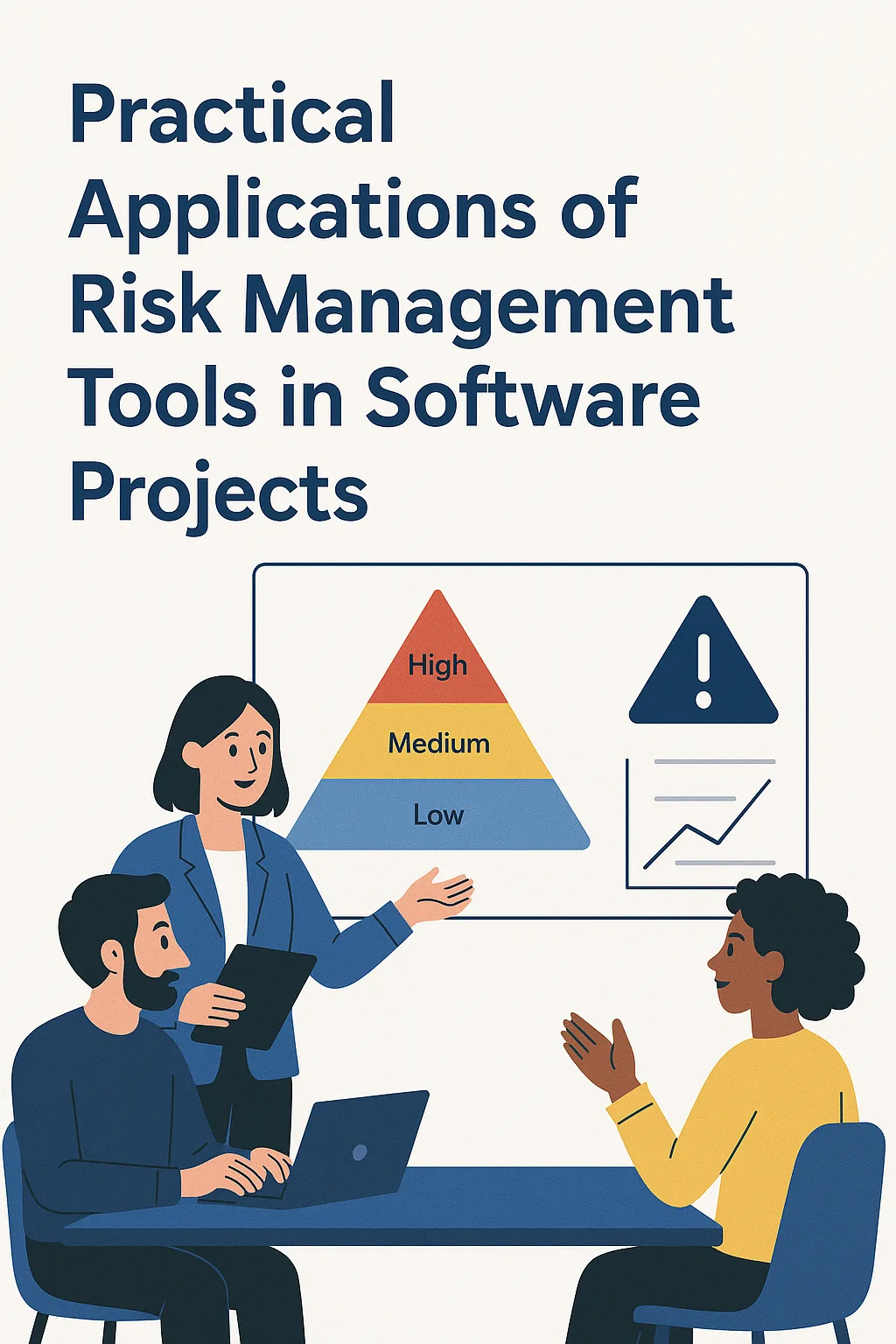Introduction to Risk Management in Software Projects
Risk management is a critical component of software project management, serving as a systematic approach to identifying, assessing, and mitigating risks that could potentially impact project success. In the context of software development, effective risk management is not just a best practice; it is essential for ensuring that projects are delivered on time, within budget, and to the required quality standards.
Significance of Risk Management in Software Projects
The significance of risk management in software projects lies in its ability to enhance decision-making and improve project outcomes. By proactively identifying potential risks, project managers can develop strategies to address them before they escalate into more significant issues. This proactive approach helps in:
- Minimizing Disruptions: Early identification of risks allows teams to implement mitigation strategies, reducing the likelihood of project delays and cost overruns.
- Improving Resource Allocation: Understanding risks enables better planning and allocation of resources, ensuring that the right skills and tools are available when needed.
- Enhancing Stakeholder Confidence: A well-defined risk management plan demonstrates to stakeholders that the project team is prepared to handle uncertainties, fostering trust and support.
Common Risks Faced in Software Development
Software projects are inherently fraught with various risks, which can be broadly categorized as follows:
- Scope Creep: This occurs when the project’s requirements expand beyond the original plan, often leading to increased costs and extended timelines. Managing scope effectively is crucial to maintaining project focus.
- Technical Challenges: Software development often involves complex technologies and methodologies. Technical risks can arise from unforeseen issues in software architecture, integration, or performance, which can derail project timelines.
- Resource Availability: The availability of skilled personnel and necessary tools can significantly impact project progress. Risks related to resource allocation can lead to bottlenecks and delays if not managed properly.
Role of Risk Management Tools in Mitigating Risks
To effectively manage these risks, software project managers can leverage a variety of risk management tools. These tools are designed to enhance the effectiveness of risk management processes by providing structured methodologies for identifying, evaluating, and prioritizing risks. Some key roles of these tools include:
- Risk Identification and Assessment: Tools can facilitate the systematic identification of risks through checklists, brainstorming sessions, and historical data analysis. They help in assessing the likelihood and impact of each risk, allowing teams to prioritize their responses.
- Monitoring and Reporting: Risk management tools often include features for tracking identified risks and their mitigation strategies. This ongoing monitoring ensures that project teams remain aware of potential issues and can adjust their plans accordingly.
- Collaboration and Communication: Many risk management tools support collaboration among team members, enabling effective communication about risks and their management. This collaborative approach fosters a culture of risk awareness within the project team.
Understanding Risk Management Tools
Risk management tools play a crucial role in identifying, assessing, and mitigating potential risks that could impact project success. These tools can be categorized into two main types: qualitative and quantitative.
Definition and Categories of Risk Management Tools
- Qualitative Risk Management Tools: These tools focus on the subjective assessment of risks based on their probability and impact. They often involve techniques such as risk matrices, brainstorming sessions, and expert judgment. Qualitative tools help project managers prioritize risks and develop strategies to address them without requiring extensive numerical data.
- Quantitative Risk Management Tools: In contrast, quantitative tools utilize numerical data and statistical methods to analyze risks. Techniques such as Monte Carlo simulations, decision tree analysis, and sensitivity analysis fall under this category. These tools provide a more detailed understanding of potential risks and their financial implications, allowing for more informed decision-making.
Key Features of Effective Risk Management Tools
Effective risk management tools share several key features that enhance their utility in software project management:
- User-Friendly Interface: A straightforward and intuitive interface allows project managers and analysts to easily navigate the tool, facilitating quick assessments and updates.
- Integration Capabilities: The ability to integrate with existing project management software is essential. This ensures that risk management processes are seamlessly incorporated into the overall project workflow, enhancing collaboration and communication among team members.
- Customizable Risk Assessment Frameworks: Tools should allow users to tailor risk assessment criteria to fit the specific needs of their projects, accommodating various project sizes and complexities.
- Reporting and Visualization: Effective tools provide robust reporting features and visualizations, such as dashboards and charts, to help stakeholders understand risk status and trends at a glance.
- Collaboration Features: Tools that support collaboration among team members enable collective risk identification and assessment, fostering a culture of proactive risk management.
Integration into Existing Project Management Frameworks
Integrating risk management tools into existing project management frameworks is vital for enhancing their effectiveness. This integration can be achieved through:
- Alignment with Project Goals: Ensuring that risk management objectives align with overall project goals helps maintain focus and relevance throughout the project lifecycle.
- Training and Support: Providing training for team members on how to use risk management tools effectively ensures that everyone is equipped to identify and manage risks proactively.
- Regular Updates and Reviews: Establishing a routine for updating risk assessments and reviewing risk management strategies keeps the project team informed of any changes in risk status and allows for timely adjustments to mitigation plans.
By understanding and effectively utilizing risk management tools, software project managers can significantly enhance their ability to navigate uncertainties, optimize project outcomes, and improve stakeholder satisfaction. These tools not only streamline the risk management process but also contribute to the overall success of software projects by fostering a proactive approach to risk identification and mitigation.
Popular Risk Management Tools for Software Projects
Effective risk management is crucial in software project management, as it helps identify, assess, and mitigate potential risks that could impact project success. Below is a review of several popular risk management tools that enhance the effectiveness of risk management in software projects, along with their functionalities, unique features, and a balanced view of their pros and cons.
1. RiskyProject
Overview: RiskyProject is a comprehensive risk management software designed specifically for project managers. It integrates risk analysis with project scheduling, allowing users to visualize the impact of risks on project timelines.
Functionalities and Unique Features:
- Risk Analysis: Offers qualitative and quantitative risk analysis.
- Schedule Integration: Links risks directly to project schedules, providing real-time updates on how risks affect timelines.
- Monte Carlo Simulation: Utilizes simulations to predict project outcomes based on identified risks.
Pros:
- Strong integration with project scheduling tools.
- Provides detailed risk reports and visualizations.
- User-friendly interface for both novice and experienced project managers.
Cons:
- Can be complex for smaller projects.
- Higher cost compared to some simpler tools.
2. JIRA Risk Management Plugin
Overview: JIRA, widely known for its issue and project tracking capabilities, also offers a risk management plugin that allows teams to manage risks within their existing workflows.
Functionalities and Unique Features:
- Integration with JIRA: Seamlessly integrates with JIRA’s project management features.
- Customizable Risk Templates: Users can create and customize risk templates to fit their project needs.
- Real-time Collaboration: Facilitates team collaboration on risk identification and mitigation strategies.
Pros:
- Familiar interface for teams already using JIRA.
- Enhances visibility of risks within the project management process.
- Supports agile methodologies.
Cons:
- Limited standalone risk management features compared to dedicated tools.
- May require additional training for effective use.
3. CA Risk Management
Overview: CA Risk Management is part of the CA Technologies suite, focusing on enterprise-level risk management. It provides a robust framework for identifying and managing risks across multiple projects.
Functionalities and Unique Features:
- Enterprise Integration: Designed to integrate with other CA tools for comprehensive risk management.
- Risk Assessment Frameworks: Offers predefined frameworks for assessing various types of risks.
- Reporting and Analytics: Advanced reporting capabilities to track risk management performance.
Pros:
- Suitable for large organizations with complex project portfolios.
- Strong analytical tools for data-driven decision-making.
- Comprehensive risk assessment capabilities.
Cons:
- May be overly complex for smaller teams or projects.
- Higher cost and resource requirements for implementation.
Practical Applications of Risk Management Tools
Effective risk management is crucial for ensuring project success and minimizing potential setbacks. This section explores practical applications of risk management tools, highlighting their effectiveness through case studies, risk identification strategies, and best practices for implementation.
Case Studies Showcasing Successful Use of Risk Management Tools
- Tech Startup Utilizing Jira: A tech startup implemented Jira as their project management software, which integrated risk tracking features. By using Jira’s capabilities, the team was able to identify potential risks early in the development process, allowing them to allocate resources effectively and mitigate issues before they escalated. This proactive approach led to a 30% reduction in project delays compared to previous projects where risk management was less structured [13].
- Financial Services Company with Risk Management Software: A financial services firm adopted specialized risk management software that focused on financial operations. This tool enabled the team to identify market risks and operational vulnerabilities. By integrating risk management into their project milestones, they successfully navigated a volatile market, maintaining project timelines and budget constraints [1].
Identifying Risks and Applying Tools Effectively
Identifying risks in software projects involves a systematic approach that can be enhanced through the use of various tools:
- Risk Management Matrix: This tool categorizes risks based on their probability of occurrence and potential impact. By visualizing risks in this manner, project managers can prioritize which risks to address first, ensuring that the most critical issues are managed effectively [3].
- Project Management Software Integration: Tools like Gantt charts and kanban boards can be integrated with risk management features to provide a comprehensive view of project status. This integration allows teams to track risks alongside project milestones, facilitating timely responses to emerging issues [2].
- Regular Risk Assessments: Implementing regular check-ins and assessments can help teams identify new risks as they arise. This practice not only keeps the project on track but also fosters a culture of continuous improvement and vigilance [8].
Best Practices for Implementing Risk Management Tools
To maximize the effectiveness of risk management tools in the software development lifecycle, consider the following best practices:
- Establish Clear Project Scope: Clearly defining the project scope at the outset helps in identifying potential risks related to scope creep and resource allocation. This clarity allows for better planning and risk mitigation strategies [8].
- Train Team Members: Ensuring that all team members are trained in using risk management tools is essential. This training empowers the team to recognize risks and utilize the tools effectively, fostering a collaborative approach to risk management [8].
- Leverage AI and Machine Learning: Incorporating AI and machine learning applications can enhance predictive risk analysis based on historical project data. These technologies can identify patterns and potential risks that may not be immediately apparent, allowing for more informed decision-making [15].
- Document and Review: Maintaining thorough documentation of identified risks, their assessments, and the actions taken to mitigate them is vital. Regularly reviewing this documentation helps teams learn from past experiences and refine their risk management processes for future projects [9].
Measuring the Effectiveness of Risk Management Tools
The implementation of effective risk management tools is crucial for ensuring project success. To evaluate the success of these tools, it is essential to establish clear metrics and gather feedback from team members. Here are some key points to consider:
Key Performance Indicators (KPIs) for Assessing Risk Management Effectiveness
- Number of Risks Identified: Tracking the total number of risks identified during the project lifecycle can provide insight into the thoroughness of the risk management process. A higher number of identified risks may indicate a proactive approach to risk management [8].
- Number of Risks that Occurred: Monitoring the actual risks that materialized during the project helps assess the effectiveness of the risk management strategies in place. A lower occurrence rate suggests that the risk management tools are functioning well [8].
- Percentage of Risks Mitigated: This KPI measures the proportion of identified risks that were successfully mitigated or managed. A high percentage indicates effective risk response strategies and tool utilization [8].
- Impact on Project Timeline and Budget: Evaluating how risk management practices have influenced project timelines and budgets can provide a clear picture of their effectiveness. Projects that stay on schedule and within budget despite risks are indicative of strong risk management [5].
- Team Satisfaction and Engagement: Assessing team members’ satisfaction with the risk management tools can also serve as a KPI. Tools that are user-friendly and enhance collaboration are likely to be more effective [5].
Gathering Feedback from Team Members
To ensure that risk management tools are meeting the needs of the team, it is vital to gather feedback regularly. Here are some strategies:
- Surveys and Questionnaires: Conducting anonymous surveys can help collect honest feedback about the usability and effectiveness of the tools. Questions can focus on ease of use, perceived value, and suggestions for improvement [6].
- Regular Check-ins: Schedule periodic meetings to discuss the tools and their impact on project management. This allows team members to voice their opinions and share experiences in real-time [6].
- Focus Groups: Organizing focus group discussions can provide deeper insights into the challenges and successes experienced with the tools. This collaborative approach encourages open dialogue and idea sharing [6].
Tips for Continuous Improvement in Risk Management Practices
- Iterative Review Process: Establish a routine for reviewing risk management practices and tools. This could involve analyzing the effectiveness of the tools used and making adjustments based on team feedback and project outcomes [4].
- Training and Development: Invest in training sessions for team members to ensure they are well-versed in using the risk management tools effectively. Continuous education can enhance their ability to identify and mitigate risks [4].
- Adapting to Project Needs: Tailor risk management strategies and tools to fit the specific needs of each project. Flexibility in approach can lead to better outcomes and more effective risk management [4].
- Utilizing Advanced Tools: Consider integrating advanced risk management software that offers predictive analytics and real-time monitoring capabilities. These tools can enhance the ability to foresee potential risks and respond proactively [6].
By focusing on these key areas, software project managers can effectively measure the success of their risk management tools and continuously improve their practices, ultimately leading to more successful project outcomes.
Challenges in Risk Management and Tool Implementation
Effective risk management is crucial for the success of any project. However, the adoption of risk management tools often encounters several challenges that can hinder their effectiveness. Below are some common challenges faced by software project managers and analysts, along with strategies to overcome them, and the importance of fostering a supportive culture and communication.
Common Challenges
- Resistance to Change: Team members may be accustomed to existing processes and hesitant to adopt new tools. This resistance can stem from a fear of the unknown or a belief that current methods are sufficient.
- Inadequate Training: Without proper training, team members may struggle to utilize risk management tools effectively. This can lead to underutilization or misuse of the tools, ultimately diminishing their intended benefits.
- Tool Complexity: Many risk management tools come with a steep learning curve. If the tools are perceived as overly complex, team members may avoid using them altogether, which can result in incomplete risk assessments and management.
Strategies to Overcome Challenges
- Foster a Change-Ready Culture: Encourage an organizational culture that embraces change. This can be achieved by highlighting the benefits of risk management tools and how they can lead to improved project outcomes. Engaging team members in discussions about the tools can also help alleviate fears and build buy-in.
- Provide Comprehensive Training: Implement training programs that cater to different learning styles. Hands-on workshops, tutorials, and ongoing support can help team members feel more comfortable and confident in using the tools. Additionally, pairing less experienced users with mentors can facilitate knowledge transfer.
- Simplify Tool Selection: Choose tools that are user-friendly and align with the team’s existing workflows. Conducting a thorough evaluation of available tools can help identify those that offer the best balance between functionality and ease of use.
Importance of Culture and Communication
The success of risk management in software projects is heavily influenced by the organizational culture and communication practices.
- Promote Open Communication: Establishing clear channels for communication allows team members to voice concerns, share insights, and collaborate on risk management efforts. Regular meetings and updates can help keep everyone informed and engaged.
- Encourage a Collaborative Environment: A culture that values collaboration fosters teamwork in identifying and managing risks. When team members feel comfortable discussing potential issues, it leads to more comprehensive risk assessments and proactive mitigation strategies.
Conclusion
The integration of effective risk management tools is not just beneficial; it is essential for the success and sustainability of projects. The dynamic nature of software development, characterized by its inherent uncertainties and complexities, necessitates a structured approach to identifying, assessing, and mitigating risks. Here are the key takeaways regarding the practical applications of risk management tools:
- Importance of Risk Management Tools: Utilizing risk management tools allows project managers to systematically identify potential risks, analyze their impact, and develop strategies to address them. This proactive approach not only enhances the likelihood of project success but also fosters a culture of preparedness within the team. As noted, risk management is a critical component that can significantly influence project outcomes, making it imperative for managers to leverage these tools effectively [4][13].
- Encouragement to Explore Tools: Project managers and analysts are encouraged to explore various risk management tools that align with their specific project needs. Whether it’s a risk register for tracking identified risks or software that facilitates risk analysis and prioritization, the right tools can streamline the risk management process and improve decision-making. By implementing suitable tools, teams can enhance their ability to respond to risks promptly and efficiently [10][12].
- Ongoing Evaluation and Adaptation: The landscape of software development is ever-evolving, which underscores the necessity for continuous evaluation and adaptation of risk management strategies. Regular audits and updates to risk management plans are crucial to ensure that they remain relevant and effective in addressing new and emerging risks. As the external environment changes, so too should the strategies employed to manage risks, ensuring that project teams are always prepared for unforeseen challenges [6][14].
In conclusion, the proactive application of risk management tools is vital for software project managers aiming to navigate the complexities of their projects successfully. By embracing these tools and committing to ongoing evaluation, project teams can significantly enhance their risk management effectiveness, ultimately leading to more successful project outcomes.
Find out more about Shaun Stoltz https://www.shaunstoltz.com/about/.
This post was written by an AI and reviewed/edited by a human.



